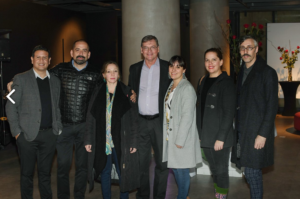
II International Seminar on Cultural Mangement
In June it was my privilege to be a presenter at the II International Seminar on Cultural Management at GAM Center for the Arts in Santiago, Chile. The focus was on territories (neighborhoods, regions, towns/cites) and communities and it provided me with a great learning opportunity to observe the practice of community engagement in South America. (There were presenters from Argentina, Peru, and Uruguay as well as Chile.)
As a result of the centrality of government funding, the emphasis in much of the work in the arts appears to be on developing connections with communities. (I’ll have more to say about the positive–and negative–aspects of such funding in the future.) I learned of:
- Peru’s Gran Teatro Nacional which, as a result of its architecture, has its back to a poor neighborhood in Lima. Staff there are working to alleviate the situation by establishing working relationships with the the people who live “behind” their building.
- Uruguay’s Artistic Training Schools (a part of SODRE) that have implemented long-term student projects working with communities as part of the curriculum.
- Site-specific theater projects in Buenos Aires in areas around the Teatro 25 de Mayo. Bombon Vecinal used homes and apartments as venues for telling neighborhood stories in a way that resembles progressive dinners, moving from one location to the next. I was particularly impressed by the investment in getting to know the residents and using the event to tell those people’s stories.
- Galleria Metropolitana, a neighborhood-based art center/gallery in Santiago. It is an extension of the home–literally, an attached tin shed–of the founding couple and has for twenty years served as a gathering place and center for contemporary art that bridges the gap between conceptual visual arts practice and social justice concerns of the area’s residents.
- KIMVNTeatro, a multi-disciplinary company focused on concerns of the Mapuche people, working directly with them in development and presentation.
- And two on-going projects using the arts to create community in unusual ways:
- Hula-la featuring lessons and performance in hula hoop (seriously). Participants bond in their shared love for the activity and spread awareness through public performances.
- Similarly, Leona’s Project is a dance training and performance program. (Instagram link) It focuses on women’s self-esteem and safety using, yep, dance hall routines and twerking. (You read that correctly.) The have a significant community following based on their pop-up performances across Santiago.
The consistent focus on connecting with individuals and groups who were not part of any typical “arts scene” was invigorating, if at times the means of connection might have been a bit . . . unusual.
Many thanks to the conference organizers as well as the participants for providing such a compelling learning opportunity for all of us in attendance.
Engage!
Doug
